Lock is a device that prevents a door or other object from being opened, moved, or operated. People use locks to help protect themselves and to guard their property against theft.
Many locks open after a person inserts and turns the correct key. But other locks, such as a combination lock, are opened by pressing a series of buttons on a keypad or by turning a dial to the correct sequence of numbers or letters. Some electronic locks are opened by inserting a specially coded “key card.” Sophisticated electronic locks open after a computer has identified a feature, such as a fingerprint, of the person desiring access.
Types of locks
There are many ways to name or describe a lock. Broad terms, such as door lock or car lock, refer to a lock’s general purpose. More specific names describe a lock more exactly. For example, the terms key-in-knob lock and lever lock both describe types of handles commonly used on door locks.
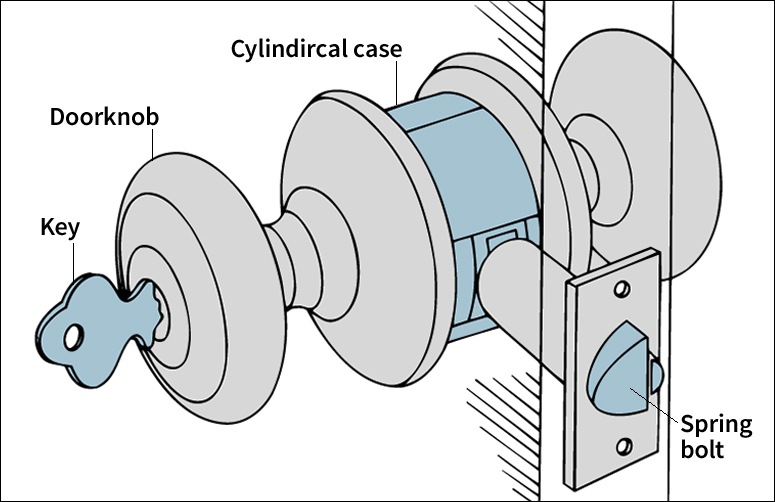
Lock terms also describe a lock’s mechanical features. The type of bolt–the long piece of metal that holds the door shut–is an important feature in door locks. A lock with a bolt called a spring latch is convenient, because it can be locked without a key. As the door closes, the doorframe presses on the bolt. This pressure squeezes a metal spring, making the bolt retract into the door. When the door is fully closed, the bolt is aligned with the strike, a metal plate on the doorframe that has a hollow area to receive the bolt. The spring then automatically pushes the bolt into the strike in the locked position. However, an intruder can easily pry open a spring latch. Locks with deadbolts are more secure. Because deadbolts lack the spring feature, they must be moved into both their locked and unlocked positions by using a key or by turning a knob or handle.
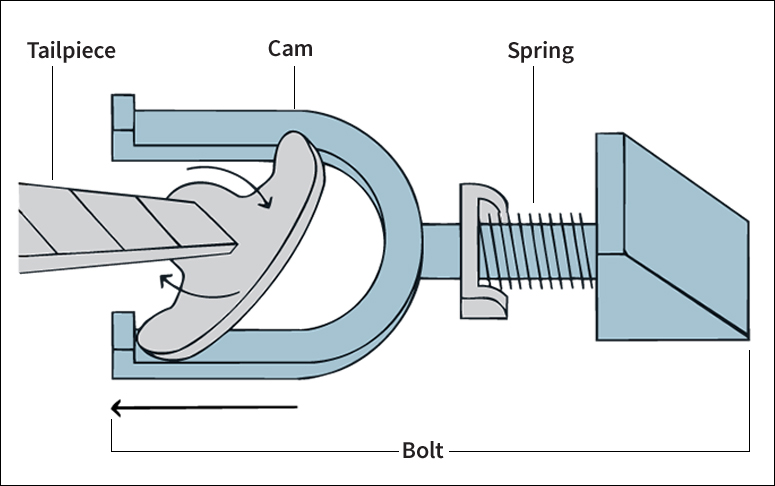
Most door locks need a key to be unlocked only from the outside. A person opens such devices, called single-cylinder locks, from the inside by pushing a button or by turning a knob or handle. Double-cylinder locks require a key to be locked or unlocked from both sides.
Locksmiths often refer to locks based on their installation method. For example, a rim lock is a lock that mounts on the surface, or rim, of a door or object. A mortise lock is installed in a hollowed out, or mortised, cavity. Padlocks are portable locks.
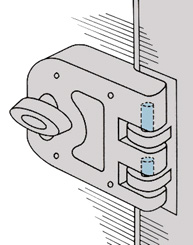
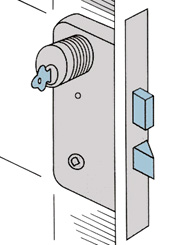
This article divides locks into two groups, mechanical and electric, according to how they work.
Mechanical locks
have moving parts that operate without electric current. There are two types of mechanical locks: warded and tumbler.
Warded locks
have several fixed ridges or obstacles called wards that block the wrong key from operating the lock. The correct key has notches cut into it that match the wards inside the lock. When a person inserts the correct key, the key fits past the wards and moves a spring inside the lock. The spring is attached to a bolt or shackle–the curved part of a padlock that snaps into the padlock’s body. When the spring moves, the bolt or shackle slides to a locked or unlocked position.
Warded locks are easy to pick (unlock) with a stiff piece of wire or thin strip of metal. Therefore, people should use warded locks in areas that do not require much security, such as closet doors.
Tumbler locks
have movable metal parts called tumblers that prevent the wrong key from opening the lock. Because tumblers provide more security than wards, most door locks use some type of tumbler arrangement.
The main part of a tumbler lock is the cylinder, also called the housing. The cylinder houses springs, tumblers, and a rotating inner core called a plug. The tumblers block the plug from turning until the proper key moves them into alignment. A piece of metal called a cam or a metal strip called a tailpiece links the end of the plug to the bolt. When the key turns the plug, the cam or tailpiece slides the bolt in or out of the strike.
There are three types of tumbler locks: (1) pin-tumbler locks, (2) disk-tumbler locks, and (3) lever-tumbler locks. Pin-tumbler locks are the most common. Tumblers in this type of lock are small pins. Most door locks on homes are pin-tumbler locks. Many automobile locks and most high-security locks also have this mechanism.
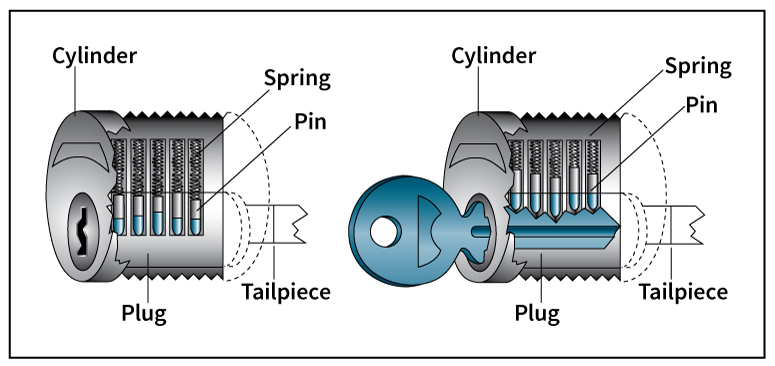
Disk-tumbler locks, also called wafer-tumbler locks, have flat disk tumblers instead of pins. When a person inserts the correct key or enters the correct combination, the disks retract into the plug. This action enables the plug to rotate and release the bolt. Many desks and file cabinets have disk-tumbler locks.
A combination padlock is a special disk-tumbler lock. It has a movable dial with a series of numbers around it. To open the lock, a person must turn the dial left and right in the correct sequence of numbers.
Lever-tumbler locks have a series of different-sized levers that act as tumblers. The levers rest on a bolt pin that prevents the bolt from moving. As a user turns the key, all the levers are raised to the same height. This action enables the bolt pin to move and release the bolt. Many briefcases and lockers have lever-tumbler locks.
Electric locks
require electric current to operate. Many electric locks include electronic devices, such as scanners that identify users and computers that process codes. Types of electric locks include (1) card access systems, (2) electronic combination locks, (3) biometric entry systems, and (4) electromagnetic locks.
Card access systems,
used in many hotels and office buildings, are the most common electronic lock systems. A person desiring access needs a card or a special “key” to unlock a door. One system uses a paperboard or plastic card, on which the code appears as a series of holes or bumps. Another system uses cards or keys that have their code on a microchip or a magnetic strip. A device reads the code and sends the information to a computer. If the code matches the one in the computer’s memory, the locking mechanism releases the bolt and the door opens.
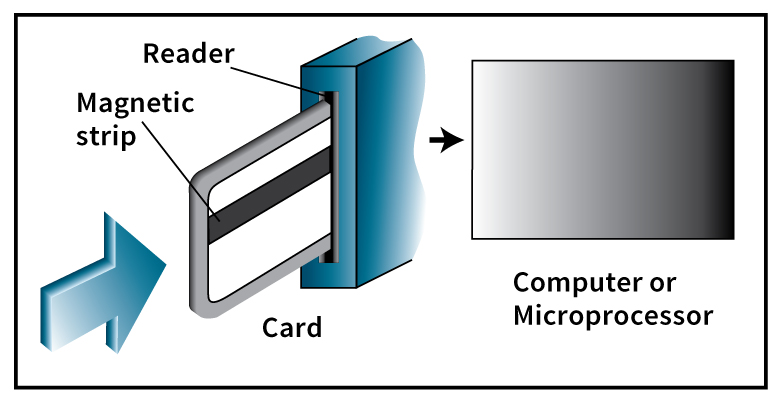
Electronic combination locks
are used in many stores and other businesses. Some electronic combination locks open after a person enters the correct combination on a numbered keypad. Other types require the user to turn a dial to enter a series of numbers. Once the person completes the combination, the computer compares it with the combination stored in its memory. If the codes match, the door opens.
Biometric entry systems
identify a person by using a computer to compare the unique features of a fingerprint, palm, voice, eye, or signature with the one in its memory. In a fingerprint system, for example, a person who wants to open the door places his or her finger on a plate. A scanner analyzes the print. If it matches the information in the computer’s memory, the door will unlock. Biometric entry systems are most often used in high-security areas, such as nuclear power plants.
Electromagnetic locks
use magnetism rather than bolts to hold a door shut. In these locks, a metal strike is mounted on the top of the door. A strong electromagnet, a device that acts as a magnet when electric current flows through it, is fastened to the doorframe in alignment with the strike. When the current flows, the electromagnet attracts the strike. Stopping the flow of current unlocks the door. Doors with electromagnetic locks often provide additional emergency exits from such buildings as schools, libraries, and museums. In some electromagnetic systems, the doors automatically unlock when a fire alarm is activated.
Other kinds of electric locks
include some types of time locks and delayed-access timers. Time locks are designed to open only at certain times on certain days. They are commonly used on bank vaults. Delayed-access timers are often used on safes in convenience stores, fast-food restaurants, and gas stations. Once the correct combination has been entered, a safe protected by such a timer can only be opened after a preset time has passed.
The development of the lock
The oldest key-operated lock still in existence was found in the citadel of King Sargon II. The citadel was built in the Assyrian capital of Khorsabad in the late 700’s B.C. Similar locks are shown in Egyptian art dating from about 2000 B.C. These large wooden locks had bolts with pegs that served as simple pin-tumblers. A matching wooden key raised the tumblers and released the bolt.
The ancient Romans developed the first warded locks. Warded locks remained the most common locks until the 1800’s.
Improvements in lock design came rapidly during the late 1700’s and 1800’s. Robert Barron, an English inventor, patented the first lever-tumbler lock in 1778. In 1784, Joseph Bramah, an English locksmith, patented the first high-security lock operated by a small, easy-to-use key. In 1861 and 1865, the American locksmith Linus Yale, Jr., patented improvements that enabled pin-tumbler locks to be mass produced. American inventor James Sargent devised the modern time lock in 1872. Card access systems and other electronic locks were introduced in the 1970’s.
See also Biometrics.
